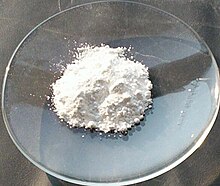Sng-hòa a-iân
Sng-hòa a-iân (Eng-gí: zinc oxide) sī chi̍t khoán hòa-ha̍k-sek ZnO ê bû-ki hòa-ha̍p-bu̍t. Pún bu̍t-chit sī bē iûⁿ-kái tī chúi lāi ê pe̍h-hún, tiāⁿ lī-ēng chò ka-thiam-bu̍t thàu tī kok khoán châi-liāu ê sán-phín, chhan-chhiūⁿ chhiū-ni, sok-ka, hûi-khì, po-lê, âng-bûn-thô͘, jūn-ku̍t-che, chhat-liāu, ko-io̍h (ointment), liâm-che, hong-che (sealants), gân-liāu, chia̍h-mi̍h, tiān-tî, khip-chio̍h hûi (ferrites), phah-hóe-che (fire retardant) kap kiù-siong theh-puh tt.

| |
| Hō-miâ | |
|---|---|
| Kî-tha hō-miâ
Zinc white, calamine, philosopher's wool, Chinese white, flowers of zinc
| |
| Sek-pia̍t-hō] | |
| ChEBI | |
| ChEMBL | |
| ChemSpider | |
| ECHA InfoCard | 100.013.839 |
| EC Number | 215-222-5 |
PubChem CID
|
|
| RTECS number | ZH4810000 |
| |
| Sèng-chit | |
| ZnO | |
| Mole chit-liōng | 81.38 g/mol |
| Gōa-māu | Pe̍h-sek kò͘-thé |
| Khì-bī | Bû-khì-bī |
| Bi̍t-tō͘ | 5.606 g/cm3 |
| Iûⁿ-tiám | 1,975 °C (3,587 °F; 2,248 K) (decomposes)[2] |
| Hut-tiám | 1,975 °C (3,587 °F; 2,248 K) (decomposes) |
| 0.0004% (17.8°C)[1] | |
| Band gap | 3.3 eV (direct) |
Chû-hòa-lu̍t (χ)
|
−46.0·10−6 cm3/mol |
Khut-chiat-lu̍t (nD)
|
2.0041 |
| Kò͘-chō | |
| Wurtzite | |
| C6v4-P63mc | |
a = 3.25 Å, c = 5.2 Å
| |
| Tetrahedral | |
| Jia̍t-hòa-ha̍k | |
Piau-chún mole
entropy (S |
43.9 J·K−1mol−1 |
Piau-chún hêng-sêng
enthalpy (ΔfH |
-348.0 kJ/mol |
| Io̍h-lí-ha̍k | |
| QA07XA91 (WHO) | |
| Gûi-hiám | |
| An-choân chu-liāu-toaⁿ | ICSC 0208 |
EU hun-lūi-hoat (DSD) (kòe-sî)
|
Dangerous for the environment (N) |
| R-phrases (kòe-sî) | R50/53 |
| S-phrases (kòe-sî) | S60, S61 |
| NFPA 704 | |
| Ín-hóe-tiám | 1,436 °C (2,617 °F; 1,709 K) |
| Lethal dose or concentration (LD, LC): | |
LD50 (median dose)
|
240 mg/kg (intraperitoneal, rat)[3] 7950 mg/kg (rat, oral)[4] |
LC50 (median concentration)
|
2500 mg/m3 (mouse)[4] |
LCLo (lowest published)
|
2500 mg/m3 (guinea pig, 3–4 hr)[4] |
| Bí-kok kiān-hong pī-pha̍k chè-hān (NIOSH): | |
PEL (Ē-thong-kòe)
|
TWA 5 mg/m3 (fume) TWA 15 mg/m3 (total dust) TWA 5 mg/m3 (resp dust)[1] |
REL (Chhui-chiàn)
|
Dust: TWA 5 mg/m3 C 15 mg/m3 Fume: TWA 5 mg/m3 ST 10 mg/m3[1] |
IDLH (Chek-sî gûi-hiám)
|
500 mg/m3[1] |
| Koan-liân hòa-ha̍p-bu̍t | |
Kî-tha im-lî-chú
|
Liû-hòa a-iân Selenium-hòa a-iân Tellurium-hòa a-iân |
Kî-tha iông-lî-chú
|
Sng-hòa cadmium Sng-hòa chúi-gîn(II) |
Tû-liáu te̍k-pia̍t chí chhut, chu-liāu sī kun-kù bu̍t-chit ê piau-chún chōng-thài (tī 25 °C [77 °F], 100 kPa). | |
| Infobox chham-chiàu | |
Sui-bóng chu-jiân-kài mā ū, it-poaⁿ sán-gia̍p lī-ēng ê sng-hòa a-iân sī ha̍p-sêng--ê.
Chham-chiàu
siu-kái- ↑ 1.0 1.1 1.2 1.3 "NIOSH Pocket Guide to Chemical Hazards #0675". National Institute for Occupational Safety and Health (NIOSH).
- ↑ Takahashi, Kiyoshi; Yoshikawa, Akihiko; Sandhu, Adarsh (2007). Wide bandgap semiconductors: fundamental properties and modern photonic and electronic devices. Springer. p. 357. ISBN 3-540-47234-7.
- ↑ Zinc oxide. Chem.sis.nlm.nih.gov. Retrieved on 2015-11-17.
- ↑ 4.0 4.1 4.2 "Zinc oxide". Immediately Dangerous to Life and Health Concentrations (IDLH). National Institute for Occupational Safety and Health (NIOSH).
| Pún bûn-chiuⁿ sī chi̍t phiⁿ phí-á-kiáⁿ. Lí thang tàu khok-chhiong lâi pang-chō͘ Wikipedia. |
